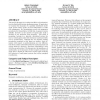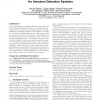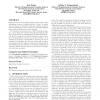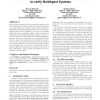ATAL
2009
Springer
14 years 3 months ago
2009
Springer
ATAL
2009
Springer
14 years 3 months ago
2009
Springer
While there has been much work on developing frameworks and models of norms and normative systems, consideration of the impact of norms on the practical reasoning of agents has at...
ATAL
2009
Springer
14 years 3 months ago
2009
Springer
The goal of this paper is to explore the effects of synchronization on distributed decision making processes. In particular, we examine the dynamics of a spatially distributed mul...
ATAL
2009
Springer
14 years 3 months ago
2009
Springer
Negotiation surrounds our day-to-day lives. Research in the field of automated negotiations has suggested the design and use of automated negotiators, on one hand to allow facilit...
ATAL
2009
Springer
14 years 3 months ago
2009
Springer
Interactive dynamic influence diagrams (I-DIDs) are graphical models for sequential decision making in uncertain settings shared by other agents. Algorithms for solving I-DIDs fac...
ATAL
2009
Springer
14 years 4 months ago
2009
Springer
Virtual Institutions are Virtual Worlds with normative regulation of participants’ interactions. This paradigm is based on normative multiagent systems and is technologically su...
ATAL
2009
Springer
14 years 4 months ago
2009
Springer
Our work presents a mechanism designed for the selection of the optimal information provider in a multi-agent, heterogeneous and unsupervised monitoring system. The selfadaptation...
ATAL
2009
Springer
14 years 4 months ago
2009
Springer
Modern peer-to-peer file sharing systems rely heavily on the willingness of users to distribute files to others. A selfish user can choose to download a file and consume resou...
ATAL
2009
Springer
14 years 4 months ago
2009
Springer
The Goal Decomposition Tree model has been introduced in 2005 by Mermet et al. [9] to specify and verify the behaviour of an agent evolving in a dynamic environment. This model pr...
ATAL
2009
Springer
14 years 4 months ago
2009
Springer
This study investigates the pros and cons of flocking in longrange “migration” of mobile robot swarms under the influence of different factors. We present a flocking behav...




